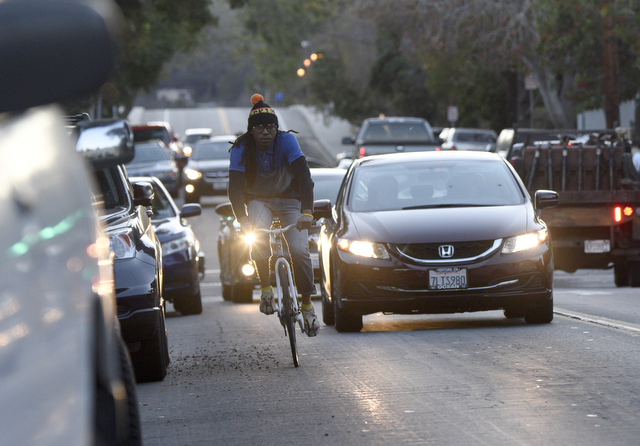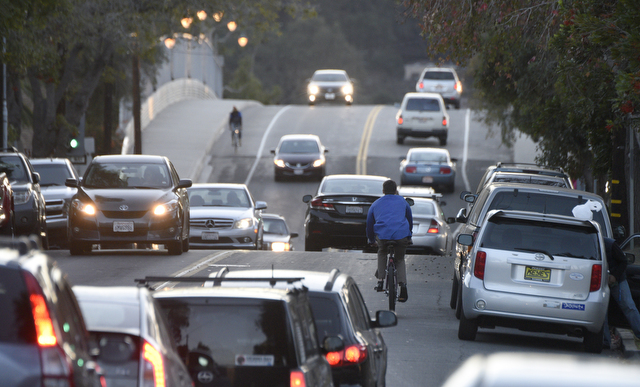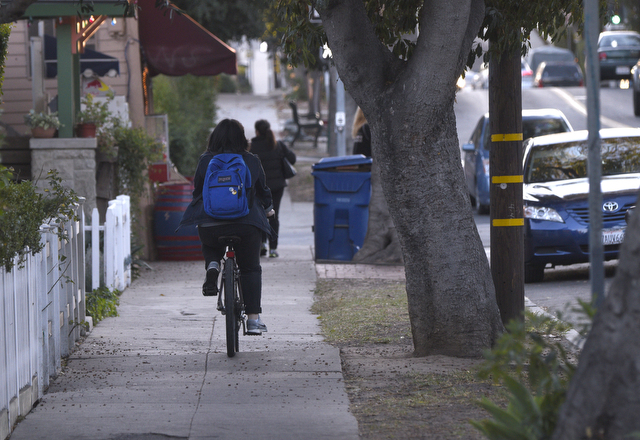Micheltorena Bike Lanes Approved by Planning Commission
City Planners Agree to Swap On-Street Parking for New Bicycle Master Plan

After much talk about cutting babies in half and other forms of logistical compromise during their lengthy Thursday-afternoon deliberations, members of the Santa Barbara City Planning Commission proceeded to lop off the baby’s head instead. At least that’s how many Micheltorena Street residents and property owners view the plan — approved by the commission by a vote of 5-to-1 — to remove 85 spaces of on-street parking along the four-block stretch between Castillo and State streets and replace them with two bike lanes, one on each side of the street.
This lanes-for-parking swap is part of the proposed new Bicycle Master Plan, and it’s by far the most controversial aspect. Neighborhood residents, who showed up in force, contend the loss of on-street parking will be nothing less than catastrophic for themselves and small businesses in the area. Businesses will be rent asunder; residents will be forced to walk several blocks from home to car, and property values will plummet.

But city planners and bicycle advocates — who made a robust showing of their own — contend the new bike lanes will plug a major gap in the city’s system of bike lanes, thus creating a safer, more inviting route for Westside residents who commute to and from work by bike. Westsiders, they note, commute to work by bike in nearly twice the numbers as city residents as a whole. And no viable alternatives to the Micheltorena Street bike lanes, they insisted, exist or are likely to in the next 10 years.
This new Bike Master Plan dovetails into the city’s relatively new General Plan, which places great premium on encouraging modes of transportation other than the automobile. That’s because city streets are decidedly finite and also because the new General Plan encourages the development of higher-density — and hopefully more affordable — housing while relaxing the parking requirements imposed on such development.
Later Thursday evening, the city’s Transportation and Circulation Committee likewise endorsed the new Bicycle Master Plan after a similar debate over the trade-offs between bike lanes and on-street parking. Before the plan is finalized, however, it must be ratified by the Santa Barbara City Council, and there the political heat — and attendant discomfort — promises to be intense.
At the Planning Commission, 19 speakers testified against the removal of on-street parking along Micheltorena Street and 12 spoke in favor. Residents and business owners — many of whom testified they bicycled to work themselves — argued there’s intense demand for the limited on-street parking as it is and that no public lots are located anywhere nearby. Business owners predicted the loss of parking would prove financially ruinous. Residents demanded to know where their cars would go, and predicted that if they were forced to walk several blocks away from their homes to their cars — particularly late at night — they’d be more exposed to potential street crime. “The neighborhood isn’t the same as it used to be,” lamented one speaker.
Some took issue with the argument that the bike lanes were needed to improve safety for cyclists, insisting that cyclists brought on their own problems by the manner in which they rode. One objected most cyclists don’t use hand signals; another suggested they dressed in dark clothes and didn’t equip their bikes with lights. Most, however, said they supported east-west bike lanes but suggested alternatives that would be less disruptive to their lives.
The most popular alternative cited by these speakers was the creation of a bicycle boulevard along West Sola Street, which many speakers noted was four feet wider than Micheltorena Street and much less traveled. City transportation planners likewise cited that as an alternative, but they insisted traffic signals would be necessary where West Sola intersects with De la Vina and Bath streets. While experienced cyclists can cross okay, they noted beginning cyclists — and those with less confidence — experience difficulty wading across those intersections when confronting peak-hour flows.
One of the key reasons for a bike lane, they argued, is to encourage new, less experienced riders to try alternate modes. Such traffic signals, they estimated, would cost about $750,000. That, they said, is twice what it would cost to stripe Micheltorena with new bike lanes. The streetlights there already exist. Because City Hall is experiencing a serious budget shortfall for such infrastructure projects, they estimated it could take five to 10 years before the funds were amassed to install the streetlights. Stop signs wouldn’t work, they said, because they would slow down relatively high volume arterials designed to handle relatively speedy traffic. The introduction of stop signs, they warned, would definitely increase the incidence of rear-end collisions.
Another alternative considered — and rejected — was the creation of what transportation wonks refer to as “one-way couplets,” complementary one-way streets flowing in opposite directions. Some speakers advocated West Sola and West Arrellaga streets to perform this function, others Micheltorena and West Arrellaga. Either scenario would require only one bike lane per street, thus obviating the need to remove so much on-street parking. Traffic planner Rob Dayton acknowledged this could be done but noted it would increase traffic congestion.

Advocates for the bike lane were on hand, as well, insisting the need for an east-west bicycle connection exists and cannot be put off until later without sacrificing the safety of bicycle commuters now. The creation of such bike lanes had been included in the last Bicycle Master Plan — written in 1998 — but nothing, they complained, had been done since then.
“How many more people have to die or be injured before they give us safe bike lanes?” demanded cyclist and Westside resident Cameron Clark. Many in the cycling community were open to the possibility of alternatives but not if it meant delays of five to 10 years. Some cited the need to fight climate change; others argued that cities that invested in cycling were “richer, fitter, and more successful.”
Planning commissioners were clearly torn. Many voiced frustration that residents living on and along Micheltorena Street were not notified until very late in the game and that the first public workshop where they could weigh in was held November 30. At that “open house,” 26 of the participants expressed support for the bike lane plan, 42 were opposed, and 17 did not express a clear opinion. “We should have had this conversation months ago,” opined Planning Commissioner Michael Jordan. Jordan would ultimately support the plan, but not before noting, “I do have a keen sense of consequence on people.”
Commissioner Sheila Lodge cast the only vote against, explaining that many of the houses built along the affected blocks were constructed before the advent of the automobile and that residents there suffer a serious shortage of off-street parking and will suffer significantly by the loss. She said City Hall needed to find the funds to install the streetlights along West Sola Street.
Commissioner John Campanella suggested making the bike lanes peak-hour only, meaning that cars could park along the street the rest of the day. This scenario would obtain until the city accumulated the funds to install the traffic lights needed to for the West Sola Street alternative. Dayton said such an approach creates enforcement nightmares.
Commissioner Deborah Schwartz was the most outspoken in favor of the new plans, noting that it’s her job to balance what’s best for the entire city, not just the needs of specific constituencies and neighborhoods. Public streets, she stressed, belong to all the citizens and should not be considered the proprietary domain of any private citizens. The first priority of such streets, she said, is to move traffic, not to park cars. Businesses who located in the neighborhood, she added, did so with their eyes wide open.
But all the commissioners took pains to press city traffic planners to figure out ways to soften the impacts the loss of parking will inevitably inflict. Schwartz and others suggested that blue handicapped-only parking spaces could be painted on the cross streets near the many doctors’ offices who serve handicapped clientele — likewise with delivery spaces. And all stressed that city staff needed to allocate staff time and money to ensuring the transition process be as painless as possible for the affected residents.



